Synthesis of Responsive Membranes for Water Recovery through Desalination of Saline Industrial Effluents
Abstract
1. Introduction
2. Materials and Methods
2.1. Materials and Reagents
2.2. Membrane Manufacture
2.3. Membrane Characterization
- Superficial morphology analysis using JEOL scanning electron microscopy (SEM) (JSM 5300). This study was carried out through deposition of a thin layer of gold on the surface of each membrane sample using a Technic Hummer 5 sputter-coated evaporator.
- Membrane thickness analysis using a Mitutoyo Absolute caliper. Thickness was measured in dry membranes, and indicated in mm.
- Pore characteristics assessed through the BET technique, using nitrogen for gas adsorption analysis.
- Membrane porosity percentage (MP%). The membranes were brought to constant weight, registering the data (W1). Then, the membranes were submerged in deionized water for two days. Subsequently, they were dried at 100 °C for 1 h and placed in a desiccator to cool to room temperature. The dried membranes were weighed again to achieve constant weight (W2). The percentage of water absorbed by each sample was calculated using Equation (1), which includes the membrane volume (Mv) and water density (wρ).
- 5.
- Membrane hydration according to water retaining percentage (MH%). The dry membrane (Wd) samples were weighed up to constant weight. Subsequently, the membranes were placed in deionized water for 5 h. The wet weight (Ww) was recorded, and water retention results were obtained using Equation (2). In addition, the swelling thickness due to MS was measured using a Mitutoyo Absolute caliper.
- 6.
- Membrane hydrophilicity was measured by means of water contact angle analysis, using a goniometer equipped with Pinnacle Studio HD v15.0 video control software and Ramé-Hart Instrument Co. controlled drip dispenser from IIM. The procedure was based on the ASTM D 2578-04, ASTM C 813-90, and ASTM D 5946-99 standards [25,26,27]. To carry out determination, 3 membrane samples of approximately 1.5 cm2 were glued onto 2 × 3 cm acrylic supports and were later compressed to obtain a flat surface. The measurement was carried out at room temperature, proceeded in triplicate by adding a 4 µL drop of tri-distilled water at 3 different points on the surface of each membrane, and videotaped for 20 s.
- 7.
- Surface charge density was assessed using a titration method. The surface of each membrane was treated with a 1 M HCl solution, in order to replace the mobile counterions with H+. Then, the membranes were washed with deionized water until they reached a neutral pH. The membrane was placed in contact with a solution of 0.1 M NaOH for 2 min. Next, 20 mL of the contact solution was titrated with a 0.1 M aqueous HCl solution, using a 1% phenolphthalein solution as indicator. The charge density on the membrane surface was calculated as the difference between the meq of the NaOH solution before and after it was neutralized. The result is reported in meq of Na+/m2.
- 8.
- Thermal Stability Profile (TGA) was analyzed using a TA Instruments Model SDT 2960 thermogravimetric analyzer, starting from room temperature up to 800 °C, at a heating rate of 10 °C per minute.
- 9.
- Mechanical behavior patterns were assessed using a TA Instruments model Q800 mechanical dynamic analyzer. Samples were analyzed with a size area of 0.4 × 3.5 cm.
2.4. Membrane Performance
3. Results and Discussion
3.1. Morphological Characteristics of PSF-SRP Membranes
3.2. Surface Characteristics of PSF-SRP Membranes
3.3. Thermogravimetric Analysis of PSF-SRP Membranes
3.4. Dynamical Analysis of PSF-SRP Membranes
3.5. Performance Evaluation of PSF-SRP Membranes
4. Conclusions
Author Contributions
Funding
Institutional Review Board Statement
Informed Consent Statement
Data Availability Statement
Acknowledgments
Conflicts of Interest
References
- Gugliuzza, A.; Basile, A. Membrane processes for biofuel separation: An introduction. In Membranes for Clean and Renewable Power Applications; Woodhead Publishing: Sawston, UK, 2014; pp. 65–103. [Google Scholar] [CrossRef]
- Shen, J.; Liu, G.; Huang, K.; Jin, W.; Lee, K.R.; Xu, N. Membranes with fast and selective gas-transport channels of laminar graphene oxide for efficient CO2 capture. Chem. Soc. Rev. 2015, 127, 588–592. [Google Scholar] [CrossRef]
- Vázquez, E.; Muro, C.; Illescas, J.; Burillo, G.; Hernández, O.; Rivera, E. Obtainment and Characterization of Hydrophilic Polysulfone Membranes by N-Vinylimidazole Grafting Induced by Gamma Irradiation. Polymers 2020, 12, 1284. [Google Scholar] [CrossRef] [PubMed]
- Vázquez-Fernández, I.; Bouzina, A.; Raghibi, M.; Timperman, L.; Bigarré, J.; Anouti, M. Influence of hydrophilic/hydrophobic protic ionic liquids (PILs) on the poly (vinylidene fluoride)(PVDF-ionic liquid) membrane properties. J. Mater. Sci. 2020, 55, 16697–16717. [Google Scholar] [CrossRef]
- Chaudhuri, A.; Sandha, K.K.; Agrawal, A.K.; Gupta, P.M. Introduction to smart polymers and their application. Smart Polymeric Nano-Constructs. In Drug Delivery; Academic Press: Oxford, UK, 2023; pp. 1–46. [Google Scholar] [CrossRef]
- Borzęcka, N.H.; Kozłowska, I.; Gac, J.M.; Bojarska, M. Anti-fouling properties of poly (acrylic acid) grafted ultrafiltration membranes–experimental and theoretical study. Appl. Surf. Sci. 2020, 506, 144658. [Google Scholar] [CrossRef]
- Saini, B.; Sinha, M.K.; Dey, A. Functionalized polymeric smart membrane for remediation of emerging environmental contaminants from industrial sources: Synthesis, characterization and potential applications. Process. Saf. Environ. 2022, 161, 684–702. [Google Scholar] [CrossRef]
- Hou, J.; Sutrisna, P.D.; Zhang, Y.; Chen, V. Formation of ultrathin, continuous metal–organic framework membranes on flexible polymer substrates. Chem. Int. Ed. 2016, 55, 3947–3951. [Google Scholar] [CrossRef]
- Al-Najar, B.; AlBuflasa, H.; Naushad, M. Smart polymer coatings for membrane antifouling applications. In Smart Polymer Nanocomposites; Woodhead Publishing: Sawston, UK, 2021; pp. 415–450. [Google Scholar] [CrossRef]
- Vanangamudi, A.; Dumée, L.F.; Des Ligneris, E.; Duke, M.; Yang, X. Thermo-responsive nanofibrous composite membranes for efficient self-cleaning of protein foulants. J. Membr. Sci. 2019, 574, 309–317. [Google Scholar] [CrossRef]
- Guclu, S.; Kizildag, N.; Dizman, B.; Unal, S. Solvent-based recovery of high purity polysulfone and polyester from end-of-life reverse osmosis membranes. SM&T 2022, 31, e00358. [Google Scholar] [CrossRef]
- He, H.; Liu, Y.; Wang, L.; Qiu, W.; Li, D.; Liu, Z.; Ma, J. Improvements of ferrate (VI) pretreatment on membrane flux and membrane rejection using cheap NaClO reagent. Water. Res. 2023, 229, 119520. [Google Scholar] [CrossRef]
- Hai, A.; Rambabu, K.; Govindan, B.; Banat, F.; Naushad, M. Smart polymeric composite membranes for wastewater treatment. In Smart Polymer Nanocomposites; Woodhead Publishing: Sawston, UK, 2021; pp. 313–350. [Google Scholar] [CrossRef]
- Warsinger, D.M.; Chakraborty, S.; Tow, E.W.; Plumlee, M.H.; Bellona, C.; Loutatidou, S.; Karimi, L.; Mikelonis, A.M.; Achilli, A.; Ghassemi, A.; et al. A review of polymeric membranes and processes for potable water reuse. J. Org. Chem. 2018, 8, 209–237. [Google Scholar] [CrossRef]
- Musarurwa, H.; Tavengwa, N.T. Stimuli-responsive polymers and their applications in separation science. React. Funct. Polym. 2022, 175, 105282. [Google Scholar] [CrossRef]
- Choi, J.Y.; Yun, T.; Kwak, S.Y. Two-step thermoresponsive membrane with tunable separation properties and improved cleaning efficiency. J. Membr. Sci 2018, 554, 117–124. [Google Scholar] [CrossRef]
- Liu, M.; Yu, C.; Dong, Z.; Jiang, P.; Lü, Z.; Yu, S.; Gao, C. Improved separation performance and durability of polyamide reverse osmosis membrane in tertiary treatment of textile effluent through grafting monomethoxy-poly (ethylene glycol) brushes. Sep. Purif. Technol. 2019, 209, 443–451. [Google Scholar] [CrossRef]
- Chen, F.F.; Su, T.; Zhao, X.T.; Pan, J.F.; Liu, L.F. A rigid-flexible interpenetrating polyamide reverse osmosis membrane with improved antifouling property fabricated via two step modifications. J. Membr. Sci. 2021, 637, 119625. [Google Scholar] [CrossRef]
- Ghasemi, H.; Abu-Zahra, N.; Baig, N.; Abdulazeez, I.; Aljundi, I.H. Enhancing fouling resistance and separation performance of polyethersulfone membrane through surface grafting with copolymerized thermo-responsive polymer and copper oxide nanoparticles. Chem. Eng. J. Adv. 2023, 16, 100528. [Google Scholar] [CrossRef]
- Hu, Q.; Zhou, F.; Lu, H.; Li, N.; Peng, B.; Yu, H.; Yuan, Y.; Zhang, H. Improved antifouling performance of a polyamide composite reverse osmosis membrane by surface grafting of dialdehyde carboxymethyl cellulose (DACMC). J. Membr. Sci. 2021, 620, 118843. [Google Scholar] [CrossRef]
- Lü, Z.; Guo, Z.; Zhang, K.; Yu, S.; Liu, M.; Gao, C. Separation and anti-dye-deposition properties of polyamide thin-film composite membrane modified via surface tertiary amination followed by zwitterionic functionalization. J. Membr. Sci. 2020, 604, 118063. [Google Scholar] [CrossRef]
- Li, Z.; Xu, Y.; Shen, L.; Li, R.; Jiao, Y.; Lin, H.; Tang, C.Y. Nano-wrinkled polyamide membrane preparation via heterogeneous surface-regulated interfacial polymerization for enhanced desalination performance. Desalination 2023, 564, 116801. [Google Scholar] [CrossRef]
- Zhao, D.L.; Yeung, W.S.; Zhao, Q.; Chung, T.S. Thin-film nanocomposite membranes incorporated with UiO-66-NH2 nanoparticles for brackish water and seawater desalination. J. Membr. Sci. 2020, 604, 118039. [Google Scholar] [CrossRef]
- Zhu, L.J.; Song, H.M.; Li, C.; Wang, G.; Zeng, Z.X.; Xue, Q.J. Surface wormlike morphology control of polysulfone/poly (N-isopropylacrylamide) membranes by tuning the two-stage phase separation and their thermo-responsive permselectivity. J. Membr. Sci. 2018, 555, 290–298. [Google Scholar] [CrossRef]
- ASTM D2578-04; Standard Test Method for Wetting Tension of Polyethylene and Polypropylene Films. ASTM International: Conshohocken, PA, USA, 2004.
- ASTM C 813-90; Standard Test Method for Hydrophobic Contamination on Glass by Contact Angle Measurement. ASTM International: Conshohocken, PA, USA, 1990.
- ASTM D 5946-99; Standard Test Method for Corona-Treated Polymer Films Using Water Contact Angle Measurements. ASTM International: Conshohocken, PA, USA, 1999.
- Yehl, C.J.; Zydney, A.L. Characterization of dextran transport and molecular weight cutoff (MWCO) of large pore size hollow fiber ultrafiltration membranes. J. Membr. Sci. 2021, 622, 119025. [Google Scholar] [CrossRef]
- Hernández, K.; Muro, C.; Ortega, R.E.; Velazquez, S.; Riera, F. Water recovery by treatment of food industry wastewater using membrane processes. Environ. Technol. 2021, 42, 775–788. [Google Scholar] [CrossRef]
- Zaragoza, S.; Muro, C.; Hernández, K.; Díaz-Blancas, V.; Sonia Martínez, M.; Francisco, R. Separation and phenol recovery from resin effluents by ultrafiltration. A proposal to use this method on an industrial scale. Chem. Eng. Commun. 2023, 210, 47–60. [Google Scholar] [CrossRef]
- Zhu, L.; Song, H.; Zhang, D.; Wang, G.; Zeng, Z.; Xue, Q. Negatively charged polysulfone membranes with hydrophilicity and antifouling properties based on in situ cross-linked polymerization. J. Colloid Interface Sci. 2017, 498, 136–143. [Google Scholar] [CrossRef]
- Mao, H.; Zhou, S.; Shi, S.; Xue, A.; Li, M.; Cai, J.; Zhao, Y.; Xing, W. Anti-fouling and easy-cleaning PVDF membranes blended with hydrophilic thermo-responsive nanofibers for efficient biological wastewater treatment. Sep. Purif. Technol. 2022, 281, 119881. [Google Scholar] [CrossRef]
- Luo, T.; Lin, S.; Xie, R.; Ju, X.J.; Liu, Z.; Wang, W.; Mou, C.L.; Ahao, C.; Chen, Q.; Chu, L.Y. pH-responsive poly (ether sulfone) composite membranes blended with amphiphilic polystyrene-block-poly (acrylic acid) copolymers. J. Membr. Sci. 2014, 450, 162–173. [Google Scholar] [CrossRef]
- Plisko, T.; Burts, K.; Penkova, A.; Dmitrenko, M.; Kuzminova, A.; Ermakov, S.; Bildyukevich, A. Effect of the Addition of Polyacrylic Acid of Different Molecular Weights to Coagulation Bath on the Structure and Performance of Polysulfone Ultrafiltration Membranes. Polymers 2023, 15, 1664. [Google Scholar] [CrossRef]
- Manohar, M.; Sharma, P.P.; Kim, D. Intercalated poly (2-acrylamido-2-methyl-1-propanesulfonic acid) into sulfonated poly (1, 4-phenylene ether-ether-sulfone) based proton exchange membrane: Improved ionic conductivity. Molecules 2020, 26, 161. [Google Scholar] [CrossRef]
- Zhu, L.; Song, H.; Wang, G.; Zeng, Z.; Xue, Q. Symmetrical polysulfone/poly (acrylic acid) porous membranes with uniform wormlike morphology and pH responsibility: Preparation, characterization and application in water purification. J. Membr. Sci. 2018, 549, 515–522. [Google Scholar] [CrossRef]
- Peng, Y.; Fan, H.; Ge, J.; Wang, S.; Chen, P.; Jiang, Q. The effects of processing conditions on the surface morphology and hydrophobicity of polyvinylidene fluoride membranes prepared via vapor-induced phase separation. Appl. Surf. Sci. 2012, 263, 737–744. [Google Scholar] [CrossRef]
- Harruddin, N.; Saufi, S.M.; Faizal, C.K.M.; Mohammad, A.W. Effect of VIPS fabrication parameters on the removal of acetic acid by supported liquid membrane using a PES–graphene membrane support. RSC Adv. 2018, 8, 25396–25408. [Google Scholar] [CrossRef]
- Junker, M.A.; Regenspurg, J.A.; Valdes Rivera, C.I.; Brinke, E.T.; de Vos, W.M. Effects of feed solution pH on polyelectrolyte multilayer nanofiltration membranes. ACS Appl. Polym. Mater. 2023, 5, 355–369. [Google Scholar] [CrossRef]
- Low, S.Q.; Ng, Q.H. Progress of stimuli responsive membranes in water treatment. In Advanced Nanomaterials for Membrane Synthesis and Its Applications; Elsevier: Cheras, Malaysia, 2019; pp. 69–99. [Google Scholar] [CrossRef]
- Sulatha, M.S.; Natarajan, U. Molecular dynamics simulations of adsorption of poly (acrylic acid) and poly (methacrylic acid) on dodecyltrimethylammonium chloride micelle in water: Effect of charge density. J. Phys. Chem. 2015, 119, 12526–12539. [Google Scholar] [CrossRef]
- Logan, J. Polyelectrolyte polymers—Types, forms, and function. In Water-Formed Deposits; Elsevier: Amsterdam, The Netherlands, 2022; pp. 747–764. [Google Scholar] [CrossRef]
- Wang, S.Y.; Gonzales, R.R.; Zhang, P.; Istirokhatun, T.; Takagi, R.; Motoyama, A.; Fang, L.F.; Matsuyama, H. Surface charge control of poly (methyl methacrylate-co-dimethyl aminoethyl methacrylate)-based membrane for improved fouling resistance. Sep. Purif. Technol. 2021, 279, 119778. [Google Scholar] [CrossRef]
- Beshahwored, S.S.; Weber, M.; Hu, C.C.; Lai, J.Y.; Chung, T.S. Effects of sulfonation degree on compatibility and separation performance of polybenzimidazole (PBI)-sulfonated polyphenylenesulfone (sPPSU) blend membranes. J. Membr. Sci. 2023, 683, 121849. [Google Scholar] [CrossRef]
- Khan, A.; Jain, R.K.; Banerjee, P.; Ghosh, B.; Inamuddin; Asiri, A.M. Development, characterization and electromechanical actuation behavior of ionic polymer metal composite actuator based on sulfonated poly (1, 4-phenylene ether-ether-sulfone)/carbon nanotubes. Sci. Rep. 2018, 8, 9909. [Google Scholar] [CrossRef]
- Saini, B.; Khuntia, S.; Sinha, M.K. Incorporation of cross-linked poly (AA-co-ACMO) copolymer with pH responsive and hydrophilic properties to polysulfone ultrafiltration membrane for the mitigation of fouling behaviour. J. Memb. Sci. 2018, 572, 184–197. [Google Scholar] [CrossRef]
- Modi, A.; Bellare, J. Efficiently improved oil/water separation using high flux and superior antifouling polysulfone hollow fiber membranes modified with functionalized carbon nanotubes/graphene oxide nanohybrid. J. Environ. Chem. Eng. 2019, 7, 102944. [Google Scholar] [CrossRef]
- Alkhouzaam, A.; Qiblawey, H. Synergetic effects of dodecylamine-functionalized graphene oxide nanoparticles on antifouling and antibacterial properties of polysulfone ultrafiltration membranes. J. Water Process. Eng. 2021, 42, 102120. [Google Scholar] [CrossRef]
- Mahdavi, H.; Karami, M.; Heidari, A.A. Preparation of mixed matrix membranes made up of polysulfone and MIL-53 (Al) nanoparticles as promising membranes for separation of aqueous dye solutions. Sep. Purif. Technol. 2021, 274, 119033. [Google Scholar] [CrossRef]
- Zhu, G.D.; Yang, C.Y.; Yin, Y.R.; Yi, Z.; Chen, X.H.; Liu, L.F.; Gao, C.J. Preparation of isoporous membranes from low χ block copolymers via co-assembly with H-bond interacting homopolymers. J. Membr. Sci. 2019, 589, 117255. [Google Scholar] [CrossRef]
- Saini, B.; Vaghani, D.; Khuntia, S.; Sinha, M.K.; Patel, A.; Pindoria, R. A novel stimuli-responsive and fouling resistant PVDF ultrafiltration membrane prepared by using amphiphilic copolymer of poly (vinylidene fluoride) and Poly (2-N-morpholino) ethyl methacrylate. J. Memb. Sci. 2020, 603, 118047. [Google Scholar] [CrossRef]
- Seah, M.Q.; Lau, W.J.; Goh, P.S.; Ismail, A.F. Greener synthesis of functionalized-GO incorporated TFN NF membrane for potential recovery of saline water from salt/dye mixed solution. Desalination 2022, 523, 115403. [Google Scholar] [CrossRef]
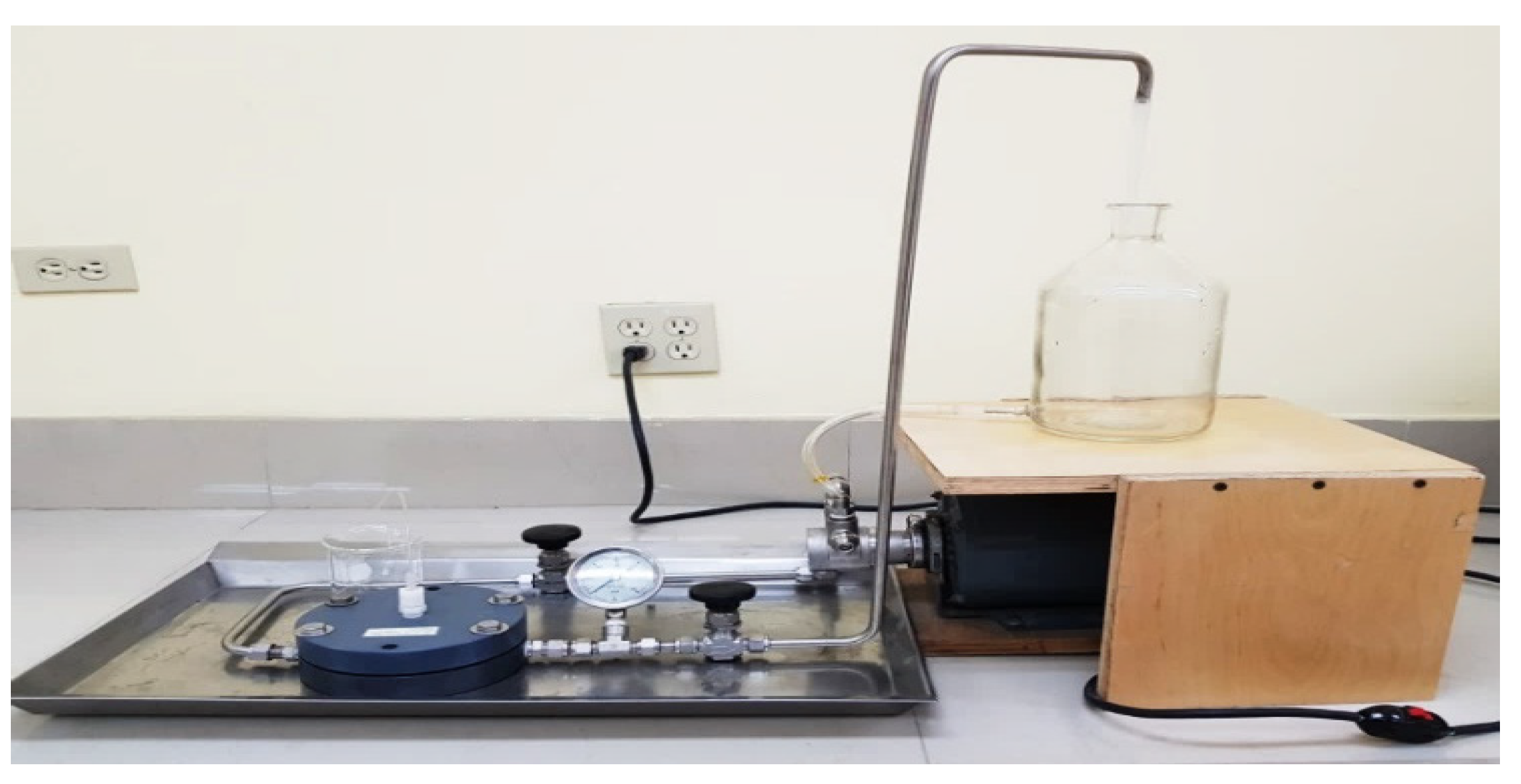
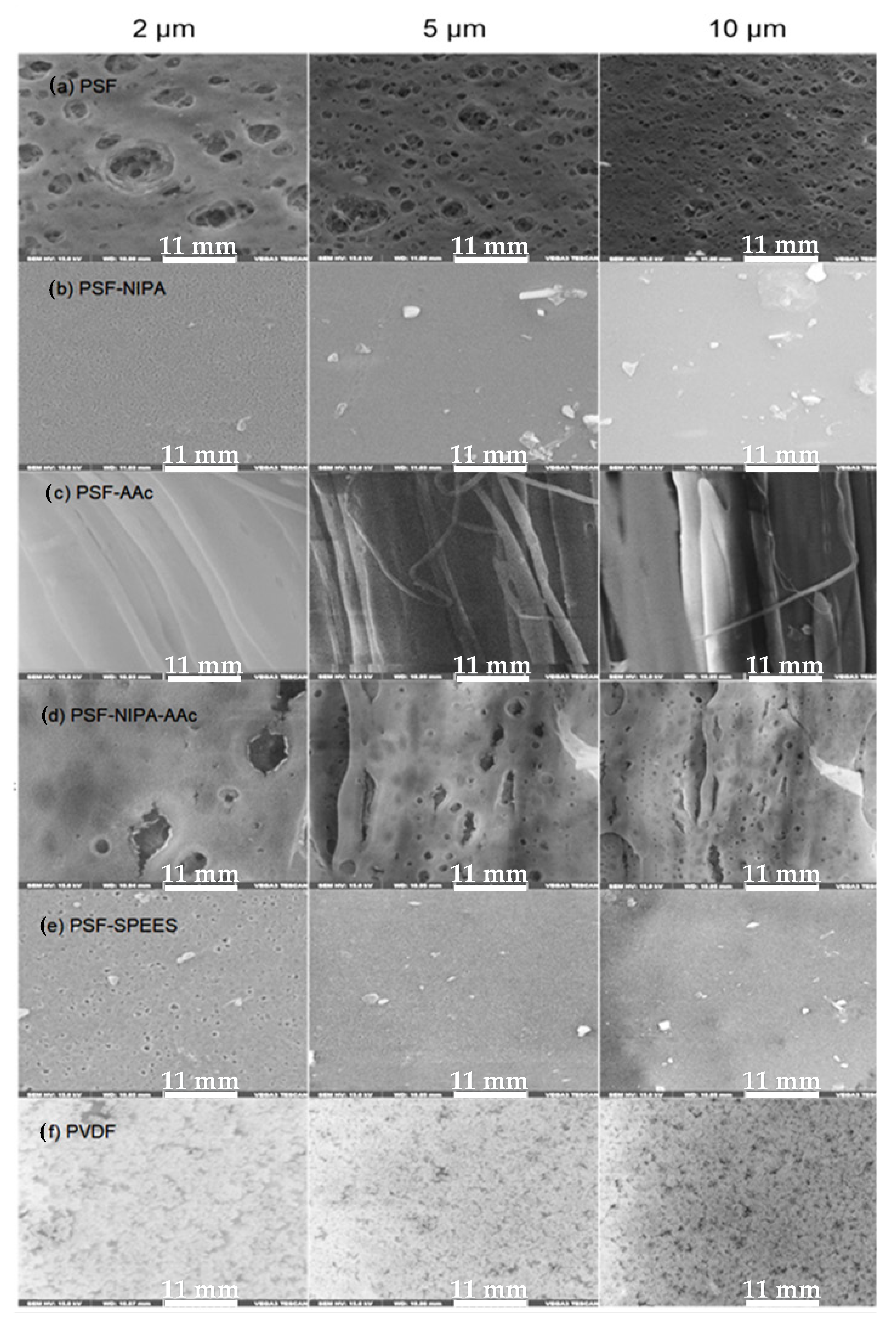
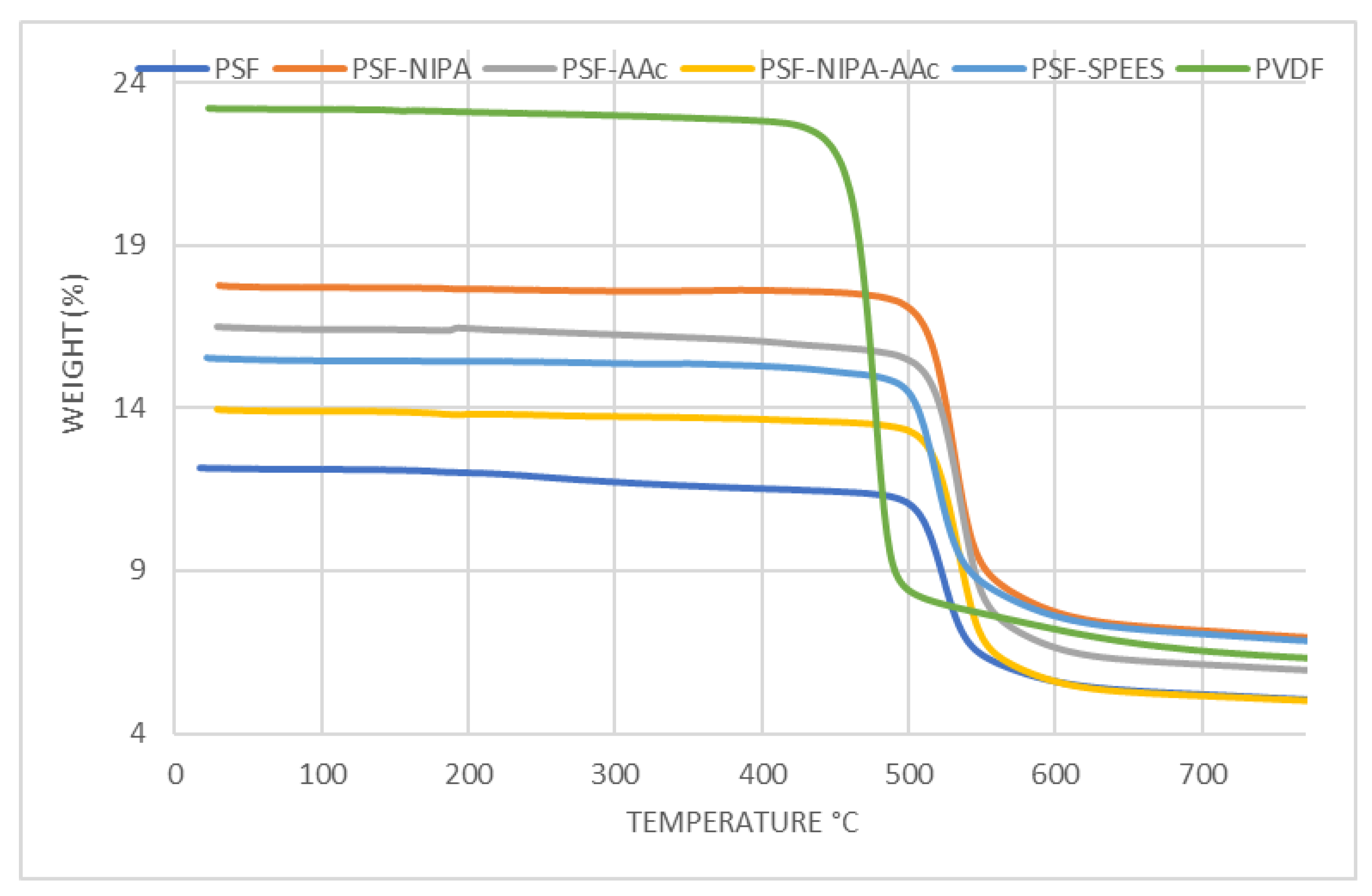
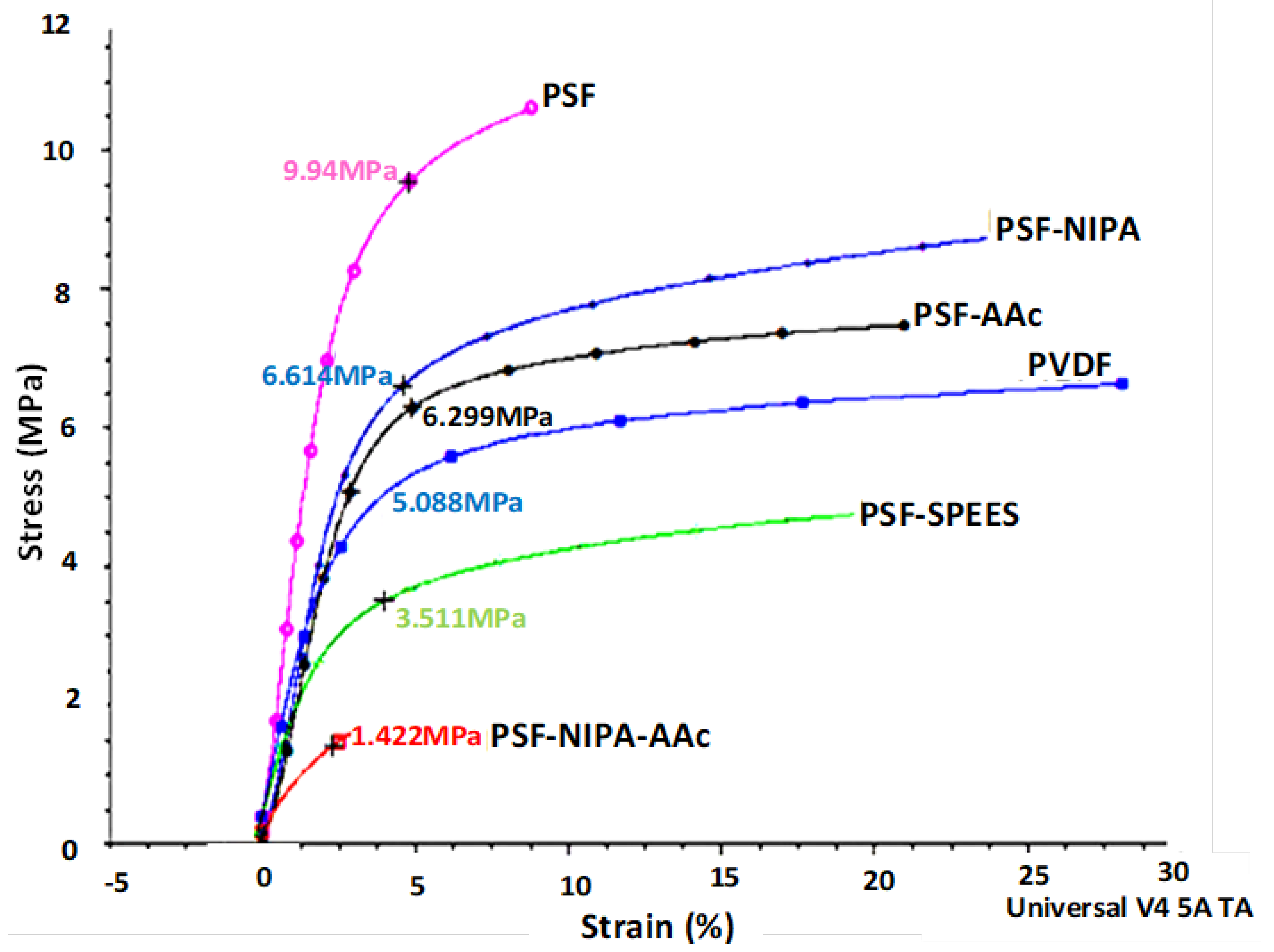

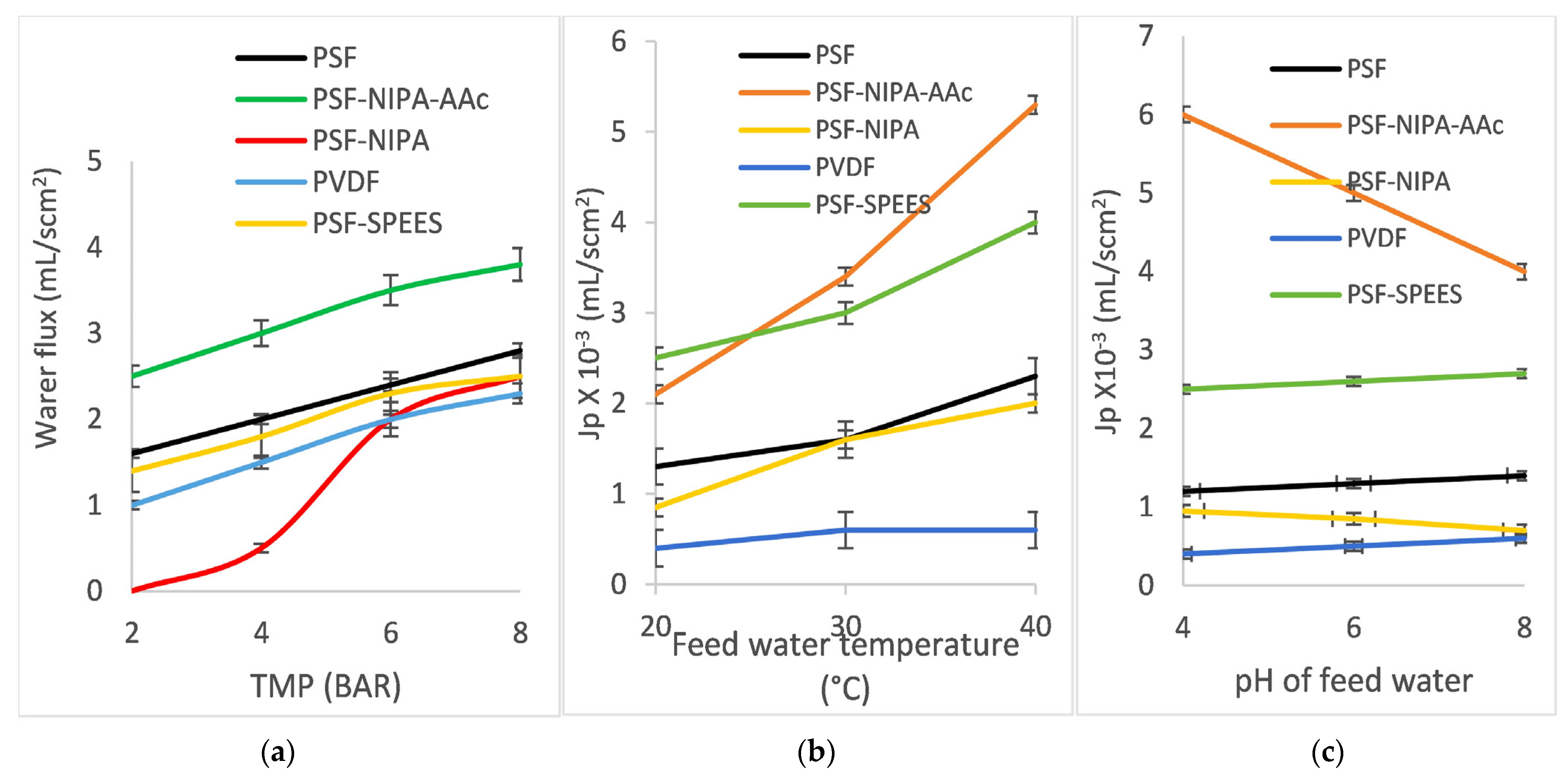

| Membrane | PSF | NIPA | AAc | SPEES | DMF |
|---|---|---|---|---|---|
| PSF | 21 | 0 | 0 | 0 | 79 |
| PSF-AAc | 18 | 0 | 3 | 0 | 79 |
| PSF-NIPA | 18 | 3 | 0 | 0 | 79 |
| PSF-NIPA-AAc | 15 | 3 | 3 | 0 | 79 |
| PSF-SPEES | 19 | 0 | 0 | 2 | 79 |
| PVDF | 21 | 0 | 0 | 0 | 79 |
| PSF-SRP Membrane/Characteristics | PSF | PSF-AAc | PSF-NIPA | PSF-NIPA-AAc | PSF-SPEES | PVDF |
|---|---|---|---|---|---|---|
| Thickness (µm) | 145 | 182 | 140 | 165 | 140 | 140 |
| Pore radius (µm) | 0.10 | ND * | 0.010 | 0.10 | 0.050 | 0.020 |
| Membrane porosity (MP%) | 60 | 15 | 80 | 55 | 70 | 75 |
| Hydrophilicity Contact angle (°) at 25 °C | 65 | 60 | 60 | 55 | 62 | 80 |
| Membrane hydration (MH%) | 28 | 48 | 30 | 43 | 31 | 15 |
| Swelling thickness (µm) | 3 | 6 | 4 | 5 | 4 | 2 |
| Surface charge densities (SCD meq Na+/m2) | 120.8 | 213.3 | 123.5 | 134.1 | 179.2 | 148.2 |
Disclaimer/Publisher’s Note: The statements, opinions and data contained in all publications are solely those of the individual author(s) and contributor(s) and not of MDPI and/or the editor(s). MDPI and/or the editor(s) disclaim responsibility for any injury to people or property resulting from any ideas, methods, instructions or products referred to in the content. |
© 2024 by the authors. Licensee MDPI, Basel, Switzerland. This article is an open access article distributed under the terms and conditions of the Creative Commons Attribution (CC BY) license (https://creativecommons.org/licenses/by/4.0/).
Share and Cite
Vazquez, E.; Muro, C.; Pérez-Sicairos, S.; Alvarado, Y.; Díaz-Blancas, V.; Hernández, K. Synthesis of Responsive Membranes for Water Recovery through Desalination of Saline Industrial Effluents. Sustainability 2024, 16, 5796. https://doi.org/10.3390/su16135796
Vazquez E, Muro C, Pérez-Sicairos S, Alvarado Y, Díaz-Blancas V, Hernández K. Synthesis of Responsive Membranes for Water Recovery through Desalination of Saline Industrial Effluents. Sustainability. 2024; 16(13):5796. https://doi.org/10.3390/su16135796
Chicago/Turabian StyleVazquez, Elizabeth, Claudia Muro, Sergio Pérez-Sicairos, Yolanda Alvarado, Vianney Díaz-Blancas, and Karina Hernández. 2024. "Synthesis of Responsive Membranes for Water Recovery through Desalination of Saline Industrial Effluents" Sustainability 16, no. 13: 5796. https://doi.org/10.3390/su16135796
APA StyleVazquez, E., Muro, C., Pérez-Sicairos, S., Alvarado, Y., Díaz-Blancas, V., & Hernández, K. (2024). Synthesis of Responsive Membranes for Water Recovery through Desalination of Saline Industrial Effluents. Sustainability, 16(13), 5796. https://doi.org/10.3390/su16135796







